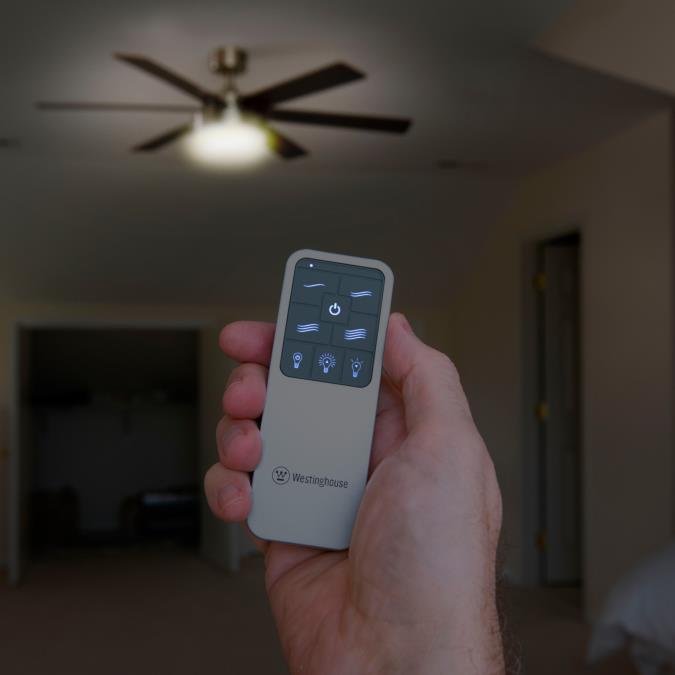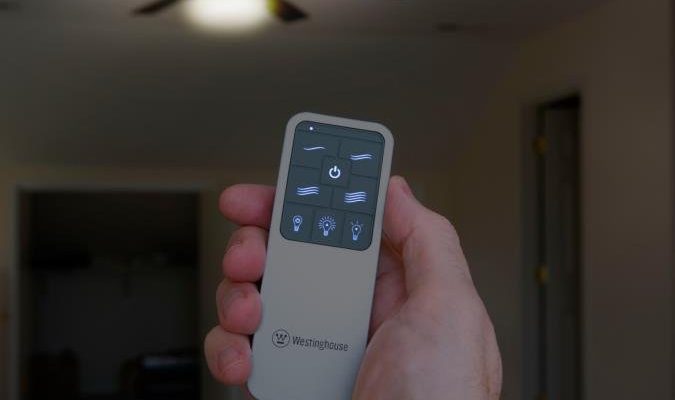
Westinghouse is one of those brands you find in a lot of homes—reliable, not too flashy, just gets the job done. Their ceiling fan remotes make it so much easier to adjust fan speeds or the light from across the room (or without leaving the couch). But when it comes to newer tech like LED bulbs, sometimes things aren’t as plug-and-play as we’d like. Let’s break down what actually happens behind the scenes and figure out if your remote and those LEDs can work together—or if you’re in for a compatibility battle.
How Do Westinghouse Ceiling Fan Remotes Control Lights?
Before jumping straight to compatibility, it helps to know what’s actually going on when you press that button on your Westinghouse remote. The remote isn’t just a light switch at a distance. Inside the ceiling fan’s canopy (that’s the part mounted to your ceiling), there’s a little receiver that listens for signals from your remote. It’s like walkie-talkies: the remote “talks,” the receiver “listens.”
Here’s the thing: The receiver controls the power flowing to your ceiling fan’s light socket. Most older fan remotes are designed to switch power on and off, and maybe adjust brightness via dimming. But they were originally built for incandescent or CFL bulbs, not LEDs. LED technology works differently because LEDs need special circuitry to manage power efficiently. If you just swap bulbs and ignore this, it might still work…or you might get flickers, buzzing, or lights that don’t turn on at all.
Key point: The Westinghouse remote doesn’t care if there’s an incandescent, CFL, or LED in the socket—it just sends power on and off, or adjusts voltage for dimming. But the bulbs have to handle what the receiver sends. That’s where problems can sneak in, especially if you use dimming features with LEDs that aren’t designed for it.
Are LED Bulbs Compatible With Westinghouse Fan Remotes?
You might be wondering, “Will my new LED bulbs actually work with this remote, or am I out of luck?” The honest answer: it depends, but let me explain why.
If you’re just using the remote for simple on/off control, most LED bulbs will work fine. The receiver simply cuts or restores power, and LEDs are happy to turn on or off. The trouble usually pops up when you try to dim the LEDs using the remote’s dimmer function. Unlike old-school bulbs, LEDs need to be labeled as “dimmable.” Non-dimmable LEDs often flicker, buzz, or sometimes refuse to light up at all when the dimmer tries to lower the voltage.
Quick story: I once swapped every bulb in my ceiling fan for shiny new LEDs, only to notice they started flashing like a disco every time I dimmed them. Turns out, I’d mixed in a few non-dimmables by mistake. Easy fix, but it sure felt like the room was haunted.
There’s another wrinkle: Not all dimmable LEDs play nice with all remote-controlled dimming systems. Some remote receivers use old-fashioned “triac” dimmers, and cheaper LEDs don’t love that. Your best bet is to pick dimmable LEDs that specifically mention “compatible with ceiling fan remotes” or “works with triac dimmers” on the box or product details.
Bottom line: Westinghouse ceiling fan remotes can work with LED bulbs, but for dimming features, choose dimmable LEDs that match your fan’s dimming technology.
Common Problems Using LED Bulbs With Fan Remotes
If you’ve already tried putting LEDs in your ceiling fan and things are acting weird, you’re not the only one. Here’s a closer look at some stumbling blocks and how to address them:
- Flickering: This is the most common issue when using LED bulbs with ceiling fan remotes. It happens when the dimmer tries to lower voltage, but the LED circuitry can’t handle the inconsistent current. If your bulbs flicker, double-check they’re labeled as “dimmable” and try another brand if possible.
- Buzzing noises: Sometimes, cheaper LEDs or certain remote receivers cause a buzzing sound you can hear when the lights are on (especially when dimmed). This can be pretty annoying if you’re trying to relax or sleep. Opt for higher-quality, dimmable LEDs and, if possible, check that they’re compatible with fan remotes.
- Lack of control: Maybe the LED bulbs don’t respond at all, or just stay at full brightness. This can happen if the remote’s dimmer output is simply incompatible with the bulb’s driver. Unfortunately, with some older remote systems, there’s no easy fix beyond upgrading the receiver or using only the on/off function.
Tip: If you run into these problems, try resetting or re-pairing your Westinghouse remote and receiver. Sometimes, a power cycle (turning off the circuit breaker for a minute) can solve minor glitches or sync issues.
How to Choose the Right LED Bulbs for Your Ceiling Fan Remote
Picking LED bulbs that’ll work with your Westinghouse ceiling fan remote doesn’t have to be a shot in the dark. Here’s a checklist to help you avoid frustration:
- Check for “dimmable” on the packaging: Only use dimmable LEDs if you plan to use the dimmer function on your remote. Dimmable LEDs are engineered to handle the varying power output from ceiling fan receivers.
- Look for compatibility notes: Some manufacturers specifically say if their bulbs work with ceiling fan remotes or certain dimming technologies (like triac dimmers). This info is usually on the box or in online descriptions.
- Stick to well-known brands: You’re less likely to have flickering or buzzing with reputable bulbs. Cheap, off-brand LEDs are often where problems pop up.
- Match wattage and socket size: Make sure your new LEDs don’t exceed the fan’s recommended wattage limit and fit the socket type (usually E26/E27 for most fans).
If possible, test one bulb before swapping all of them. That way, if there’s a compatibility issue, you can return the rest and try a different brand.
Resetting, Syncing, or Troubleshooting Your Westinghouse Remote With LEDs
Let me walk you through what to do if your new LED bulbs and Westinghouse remote aren’t playing nice. Sometimes, the issue isn’t the bulbs—it’s a code, sync, or pairing problem with the remote and receiver. Here are step-by-step tips:
- Replace the batteries in your remote. Weak batteries can cause inconsistent signals that confuse the receiver.
- Reset your remote and receiver. Most Westinghouse remotes have a tiny reset or pair button inside the battery compartment. Press and hold this button (check your manual for the exact method). This clears out any confusion between the remote and receiver so they can “talk” cleanly again.
- Power cycle the fan. Turn off the breaker supplying power to your ceiling fan for about 30 seconds, then turn it back on. Sometimes, this helps the receiver “forget” any glitches from a recent bulb swap.
- If you’ve upgraded your bulbs but still have issues, try re-pairing the remote with the fan according to the Westinghouse instructions. This usually involves pressing set or pair buttons in a certain sequence.
- Still having trouble? Consult the Westinghouse troubleshooting guide for your exact fan model. There may be a firmware update or a known compatibility fix.
Insight: Honestly, many remote and receiver issues show up after changing bulbs because the whole system gets “confused.” A quick reset or re-pair usually clears things up.
Comparing Westinghouse Remotes to Universal Fan Remotes
If you’re dealing with persistent issues, you might consider switching to a universal fan remote. But before you jump, it’s worth understanding the tradeoffs.
- Universal remotes can work with lots of brands and fan types. Some are designed specifically to handle LED dimming better than older brand-specific remotes.
- Brand-specific remotes, like those from Westinghouse, are guaranteed to match the receiver’s features—up to a point. But if both are older, they may not expect the quirks of LEDs. If you’re thinking of upgrading, look for remotes that highlight “LED compatibility” or offer adjustable dimming curves.
- Sometimes, the issue isn’t the remote but the receiver in the fan canopy. Upgrading that to a newer, LED-friendly model can solve flicker and buzzing once and for all.
Personal take: If your Westinghouse remote is working fine for basic on/off, there’s no need to upgrade. But for serious dimming, a universal remote made for LEDs might save you a lot of headaches.
Why Bother Upgrading to LEDs in Ceiling Fans?
You might be asking, “Is all this hassle even worth it?” Here’s where the math and comfort factor come in. LED bulbs use way less energy, so you’ll see real savings on your power bill—especially if you leave ceiling fans on a lot. They also last for years, meaning you won’t need to drag the ladder out so often.
But here’s the big win: LED bulbs give off less heat. If you’ve ever stood under a ceiling fan that doubled as a space heater in summer, you’ll appreciate this upgrade. Some fans are super sensitive to excess heat, so switching to LEDs helps them last longer, too.
Perspective: Once you find the right bulbs that talk nicely to your Westinghouse ceiling fan remote, you’ll get all the modern benefits—without losing the convenience of remote control.
Key Takeaways for Using Westinghouse Ceiling Fan Remotes With LED Bulbs
To boil it all down: You absolutely can use LED bulbs with your Westinghouse ceiling fan remote, but only if you pick the right type. For on/off control, nearly any LED bulb works. For dimming, you need to hunt down “dimmable” LEDs and, if you want total peace of mind, check they’re made to work with fan remotes or triac-based dimmers.
If you run into flickering, buzzing, or unresponsive bulbs, don’t panic—try resetting, syncing, or pairing your Westinghouse remote, and double-check your bulb choices. Sometimes, investing in a better-quality LED or even upgrading your remote/receiver makes all the difference.
In the end, combining the energy savings of LEDs with the convenience of your Westinghouse ceiling fan remote is totally doable. It just takes a little patience and the right bulbs. Once everything is working, you’ll wonder why you didn’t make the switch sooner.
